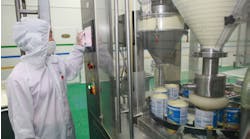| Question from August's Chemical Processing
We are experiencing high torquing problems and an increase in material temperature in our 6-ft.-diameter ribbon blender. We mix a dry, coarse ingredient with oil and then add a fine powder and mix for about 30 minutes. We feed the coarser material into one end of the blender and add the powder to another area. The oil is sprayed into the mixture using fan sprays. About 20 minutes into the mixing process, the torque increases substantially and the bulk mixture&rsquos temperature rises to about 90°F. What could be causing the torquing problem? Will changing the mixture reduce the overload? |
Diamondback Technology Inc., San Luis Obispo, Calif.
Evenly distribute the liquid
We perform a similar operation at our plant. First, we add all the liquid ingredients to the coarsest fraction. Once this is thoroughly mixed, we add the finer powders. This procedure eliminates about 90% of the heat buildup we used to experience.
The tendency to thicken and bulk is likely due to the oil absorption capacity of the finer powder. By predistributing the liquid, the bulking takes place throughout the mixer rather than in the middle zone. As a result, the torque required to mix is substantially reduced for any small, finite volume. If you need to add additional oil, do so after the pre-wet, coarse and fine powders have been thoroughly mixed.
Gary Hall, manager, organic technology
Add materials in a different order
It sounds as if your process is creating a dilatant solution, not unlike a mixture of cornstarch and water where the more you mix it, the thicker and more viscous it becomes. The increased heat most likely is caused by the high viscosity and friction between the ingredients, or a pure chemical reaction between your materials.
You may have to limit the mixing or change the sequence in which ingredients are added. If you can get the powders mixed before adding the oil, you should get the best final mixture with the least amount of mixing time and lessen your torque issues.
Kurt Lemman, maintenance engineering manager
Schreiber Foods Inc., Tempe, Ariz.
Vary the concentration
I suspect that you may be reaching the static packing point of the particles. The coarse material is packing so close that the individual particles have to move up and over each other instead of just flowing past in near proximity. It could help to vary the concentration to make the mixture a little more fluid.
Mont Dutson, staff engineer
DuPont Chemical Co., Fort Madison, Iowa
Consider a few things first
Many blending and drying processes go through a nasty &ldquoballing&rdquo stage that would explain the high torque and temperature. If the balls that form are very sticky, it makes the situation much worse. As the wet material contacts the dry, it will roll and fold causing balls to form. As more wet material is added, the balls break up and the blending becomes more uniform and reduces the torque.
The order and rate of material addition are the main factors. The type of blender and the blender impeller also have an effect. The torque and temperature can be related using equations developed by the English scientist James Prescott Joule. His work with water was so precise despite his primitive equipment that even modern equipment and methods have hardly changed the values that he determined.
There are some questions you should ask: Are all the meters for material additions calibrated? Or were they recently calibrated for the first time? If material rates have been modified even slightly, the effects can be dramatic. Have you tried adjusting the addition rates or order? Can you see inside during operation? Can you stop processing at various points and take a sample? You should consider non-linear addition rates. Has the process changed in any way or has it always behaved this way? Were the issues manifested during scale-up? Scaling up blending operations is notoriously non-linear. You can measure the temperature or torque over time and use it to determine if the changes you are making show any progress.
Eric Janson, project engineer
Bristol-Myers Squibb Co., Syracuse, N.Y.
Use a dispersant
If you add the coarse and then the fine ingredients, you might wet out the product and get better results. It also might help to use a dispersant if your chemical process will allow it.
Rob Bechtel, lab manager
The Shepherd Color Co., Cincinnati
Check the surface area of the powders
High torque and temperature increase go hand in hand with increased viscosity. Apparently the fine particles are absorbing the liquid, resulting in higher viscosity and higher torque with increased temperature. If this is something that has occurred only recently with no change in materials, you should check the surface area of the particles. It may also help to add additional liquid or reduce the percentage of fine particles in the mixture since they usually absorb more liquid than larger particles.
Sam Firestone, CEO
Norstone Inc., Wyncote, Pa.
Add the oil last
The ribbon blender is putting a great deal of energy into the mixture. The combination of the coarse and fine materials is creating a dense product once the oil is added. The increased sheer is generating the heat. I would suspect that as the mass becomes wetter, the longer the blender needs to be operated. I would suggest first blending the coarse and fine materials and then adding the oil. Blend the mixture for five minutes or less.
Kief Hess, operations technical leader
Crompton Corp., Morgantown, W.Va.
Slowly add fine powder
I believe a simple change may solve the problem of higher torque and heat. Assuming there is no reaction taking place between the oil and solids, I would spray the oil on the coarse powder and run the blender until the oil thoroughly coats it. Once that is done I would slowly add the fine powder so that it starts to adhere and coats the oil-coated coarse particles.
Girish Malhotra, P.E.
EPCOT International, Pepper Pike, Ohio
Ask an expert
You could consult a rheologist who knows how your ingredients interact. Nevertheless, you have a non-Newtonian mixture with rising temperature due to increasing shear (or an exothermic reaction). Postulating the need for a very uniform mixture, one might try for uniformity by mixing the solids before adding the oil. But the better bet would be a double-cone mixer or a muller.
Take the ingredients to two or three mixing-equipment vendors&rsquo labs and let them decide how they would do it. If the cost of new equipment is high, you can look into buying used equipment.
Tom Murphy, P.E.
Add some more lubricant
It seems like your ingredients are reacting exothermically. It&rsquos also possible that the amount of lubricant is insufficient or is being atomized or used up.
David Goodson, president
Stealth Coatings Co., Hinsdale, Ill.
Check the driver&rsquos specs
The viscosity of your mixture may be changing as a result of a reaction between the oil and the solid material. Check the actual viscosity with a viscometer. Then check the specifications of the mixer driver to be sure that the mixture&rsquos viscosity is within the specs. You may have to increase the horsepower of the driver or use a different oil for the mix. You also may have a problem of over-mixing the material, thereby increasing the rate of reaction.
Have your drivers been failing prematurely? Evaluate the problem from all angles: viscosity as a function of reaction, mixing parameters and driver size.
Eric M. Roy, principal engineer
Westlake Group, Sulphur, La.
Look for a reaction
Is there a reaction causing the increase in temperature?
If the mixture becomes less viscous, you can anticipate an increase in torque. Consequently, the blending action will cause a temperature rise due to friction in a less viscous mixture.
Scott J. Evans, manager, process laboratories
F. L. Smidth Inc., Bethlehem, Pa.
The oil and powder are interacting
It appears that the interaction between the oil spray and the coal or the dry ingredient is causing the powder to swell or even soften. This often happens when dry-blending PVC powder and a plasticizer. Coal is a mass of chemicals, especially soft coal, and an interaction with petroleum-based oil is very likely.
Dan Ryan
| DECEMBER'S PUZZLER We use a light stripping column for removing methane and lighter components from natural gas liquids (NGL). We are having flooding problems with the column that we think might be due to water (the feed is saturated). Simulation shows all the water should go overhead and no hydrates should form. The first tower has a condenser temperature of -20°C (-4°F, a bottoms temperature of 84°C (183°F) and an operating pressure of 20 bar (295 psig). Could our simulation be wrong? What else could be going on? Send us your comments, suggestions or solutions for this question by Oct. 29. We&rsquoll include as many of them as possible in the December 2004 issue. Send visuals, too &mdash a sketch is fine. E-mail us at [email protected] or mail to ProcessPuzzler, Chemical Processing, 555 W. Pierce Rd., Suite 301, Itasca, IL 60143. Fax: (630) 467-1120. Please include your name, title, location and company affiliation in the response. |

